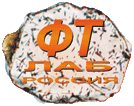| Geological Institute RAS |  |
||
| tel.: +7(495)230-8029, fax: +7(495)951-0443 | |||
| e-mail: gin@ginras.ru | |||
|
перейти на
русский
|
|||
The history of Laboratory fission-track and mineral analysis
| Geological Institute RAS |  |
||
| tel.: +7(495)230-8029, fax: +7(495)951-0443 | |||
| e-mail: gin@ginras.ru | |||
|
перейти на
русский
|
|||
The history of Laboratory fission-track and mineral analysis
Laboratory fission-track and mineral analysis was created after joining
the Institute of the Lithosphere of Marginal Seas to Geological institute RAS
(GIN RAS) in 2004. The laboratory was organized on decision of the Scientist
Council (the order № 61 from 21 june 2004). Two research groups were joined
to new laboratory. The first is group of mineral analysis under the leadership
of Dr. V.V. LYAHOVICH. The second is group of fission-track analysis under the
direction of Dr. A.V.SOLOVIEV.
 |
|
 |
|
Each of groups has its own history.
The group of mineral analysis. The group of mineral analysis was created and was leaded since 1954 by Dr. V.V.LYAHOVICH. Group is supply with equipment, allowing separate the main and accessory minerals from different types of rocks. The process of separation is divided on 6 stages: crushing, washing, separation by heavy liquids, electromagnetic separation, centrifugal treatment and flotation. Chosen minerals can be used for decision of geochronological, petrological, geochemical, metallogenic and stratigraphic questions.
 |
|
| Foto by P.W.Reiners (Yale University) | |
 |
|
| Foto by P.W.Reiners (Yale University) | |
 |
|
| Foto by P.W.Reiners (Yale University) | |
 |
|
The main tasks of the first group are:
1. Making the technological schemes allowing select the monomineral fractions of the main and accessory minerals from different types of rocks
2. Studying the rare elements in igneous rocks.
3. Reveal and install the indicator signs of minerals, which can be used at decision of some geological problems.
According to these tasks
the group was divided on technical and scientific parts. There were Cott A.G.,
Pikkat-Ordynskoy A.P., Zelenko I.S., Kryukova M.G., chemist Levchenko L.S.,
senior laboratory assistants Golovanova L.P., Zaburdina L.K., Demina G.S., Oradovskaya
T.L., Pichugina G.N., Shokorova B.N., Zaborina K.A. in the first part of the
group. The equipment of it consisted of jaw and roller crashers (big and small),
mechanically and disc grater, separation table - KC-30, drying closet, big craters
for fission in bromoform, Goliaf's lamps, manual, roller and isodynamic electromagnets,
centrifuge and flotation machines.
The scientific group consisted of mineralogists: Noneshnikova V.I., Chervinskaya
A.D., Brusnicina N.V., Ivanova T.A. and senior laboratory assistants: Filatova
G.P., Sergeeva V.I., Kasaeva T.A. This group studied such questions as:
- a revealing of the average contents of rare and ore elements in the main and accessory minerals.
- a discovery of average coefficients of accumulation of these elements in late generations of minerals.
All are these data were studied for the first time, comparing to them other geological data, we had possibility more validly judge:
1. About part of main magma in forming granite magma,
2. About degree of metal-bearing of the granite magma;
3. About magmatic or non-magmatic origin of granite,
4. About reality of processes of assimilation in the different composition granites forming.
Group of fission-track
analysis. As a result of collaboration of our Institute with Union College
(Schenectady, USA) and Yale University (New Heven, USA), begun in 1993, A.V.SOLOVIEV
studied the fission-track method in 1998-2000. The Prof. J.I.GARVER (http://idol.union.edu/~garverj/garver/garver.html
- Union College) and Prof. M.T.BRANDON (http://love.geology.yale.edu/~brandon/index.html
- Yale University) supported the development of the fission-track laboratory
in Moscow. The creation of fission-track laboratory has begun in 2000 in the
Institute of the Lithosphere of Marginal Seas with support of director Dr. Nikita
Alekseevich Bogdanov. Enormous assistance with buying the equipment has rendered
by Prof. J.I.GARVER The microscope fitted with an automated stage and digitizing
tablet was bought under financial support the National Science Foundation (Project
OPP-9911910 for J.I.Garver). The investigations and development of the fission-track
laboratory were supported by Russian Foundation for Basic Research (projects
98-05-64525, 02-05-64967, 05-05-64066), by program №6 of the Earth Research
Branch of RAS and by Russian Science Support Foundation. The development of
the laboratory was made possible in part by Award No. RG1-2568-MO-03 of the
U.S. Civilian Research & Development Foundation for the Independent States
of the Former Soviet Union (CRDF).
Dr. A.V.SOLOVIEV leads the group of fission-track analysis.
 |
|
| Foto by Prof. J.I.Garver |
Fission-track analysis can
be used for solving the various tectonic problems.
further> to
the top^